
|
| The Elbolton burials by artist Celia King |
A previous post highlighted the Faerie folklore connected with Elbolton Hill, near Grassington in the Yorkshire Dales. The hill is also significant in archaeological terms as it is the location of a Neolithic burial cave. The modern OS maps mark it as Elbolton Cave, but in the past it was called the Knave Knoll Cave. The local Dales accent must have baffled the OS map surveyors in the 1840's, who recorded it as "Navvy Noddle Hole".
A visit in August 2021 found the entrance to the cave just below a limestone outcrop high up on the east side of the hill. Unfortunately there is a 8m vertical drop down into the actual burial cave, which means that today it is only really visited by cavers with climbing gear. This was a little frustrating as the excavation of the cave had revealed a group of rather unique burials, carbon dated to the early Neolithic (3900BC), and so it would have been interesting to look inside the cave.
October 2022 saw a return visit to Elbolton, this time with a rope ladder, additional safety line and a hard hat. Being neither a climber or a caver, the descent down the shaft was a little daunting, especially the final drop, but touching down on the cave floor provided some reassurance. Scanning around with the head torch revealed the extent of the chamber was not large (approx 8m x 6m and 10m high), with a passage dropping down into the darkness in the north west corner. The torch also highlighted red markings on the walls, and for a brief moment hinted at the presence of ancient cave paintings, but in reality these were the reference points used during the excavation.
The cave excavation was undertaken by the Rev. Edward Jones of Embsay,
in the late 1880's, but the level of detail recorded was quite low. The cave
floor was lowered significantly during the digging, so the original
chamber would have been smaller than it is today. This floor surface was made
up of limestone rubble, several feet in depth, which had built up over
thousands of years from fragments dropping from the cave roof and walls.
Excavating down through this layer revealed large quantities of animal bones,
along with human bone, and pieces of pottery. Three intact human skeletons
were uncovered, and these were unusual because they were ..."buried in an upright sitting posture, the knees being close to the skull,
the thigh bones still inserted in the sockets of the pelvis. (Jones 1889).
Two of these skeletons were against the south wall of the cave, one
being located in a recess in the rock. Both these skeletons were partly
enclosed by a semi circle of large stones forming a "fender" or low wall
separating them from the rest of the cave. All the human bones uncovered in
the excavation suggested that at least 11 people had been buried in the cave,
along with one cremation burial. Apart from the 3 intact skeletons, most of
the other human bones were found scattered (possibly deliberately) amongst the
limestone rubble in the western part of the cave.
The recess where the sitting skeleton was found would appear to be the
one with the rather suggestive crevice in the back wall (see image below).
This narrow opening extends back into the rock, and a trickle of water flows
from it. Looking at this part of the cave wall, there are signs that it was
roughly shaped to accept the two bodies which sat one metre apart. It has been
suggested that the 3 complete skeletons were the remains of bodies that were
placed in the cave and left to become mummified. It is also worth noting that
the recess where they sat is opposite the entrance shaft, and so light
entering the cave would illuminate a faint path across the cave floor towards
them.
The skeletons are now in the Craven Museum in Skipton, and they
have recently been carbon dated to around 3800BC, so they sat in the cave for
almost 6000 years. It would be interesting to know if this couple, placed side
by side, were male and female?

|
|
Recess in the cave wall where two of the Skeletons were found (note the suggestive crevice at the back of the recess) |
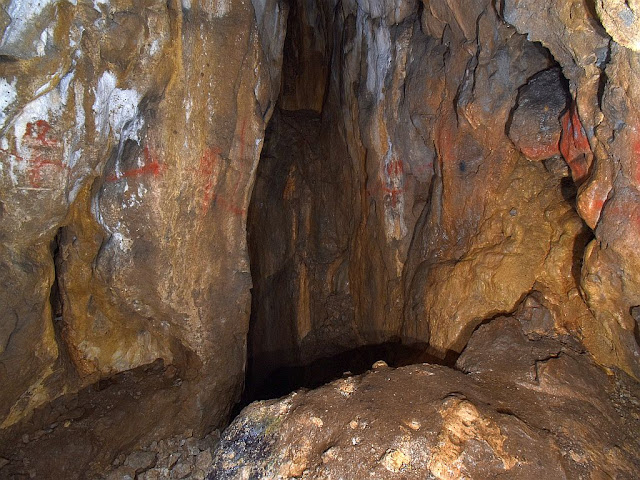
|
|
The recess (on the left) and the passage way leading off the main
chamber |
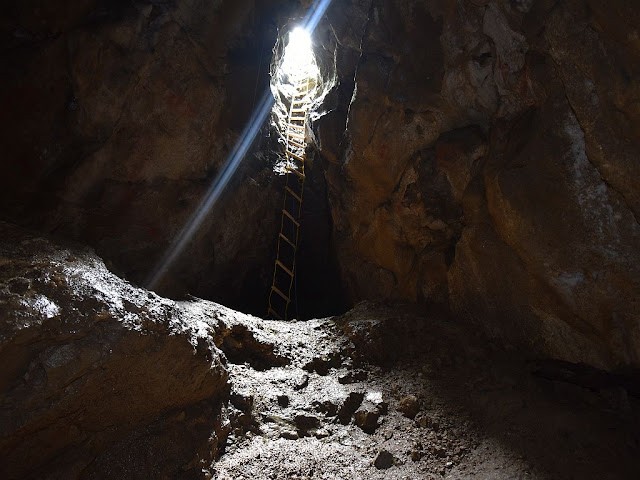
|
|
Path of light from the cave entrance towards the recess |
There are quite a few initials carved on the cave walls, with some being high up, suggesting that they may pre date the 1880's excavation. Other marks on the walls probably relate to the excavation work, but there are also areas of what appear to be scratched lines on at least two rock surfaces. Some of the lines form a criss cross pattern, while others intersect in a more random way. Although difficult to photograph, something about these markings suggests that they may be much older, and worth further investigation.
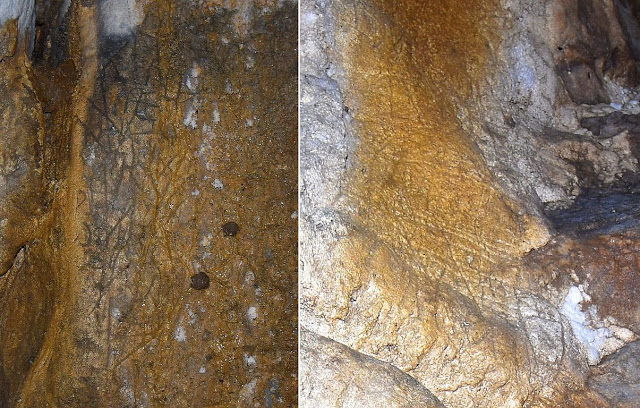
|
|
Markings on the west and east walls of the cave |
After thoughts
The lack of detail recorded in the excavation raises many questions -
such as were the bodies of the sitting skeletons placed in pits dug into the
rubble of the cave floor, or had they been placed on an older floor surface,
and gradually become buried over time? Also, many of the larger animal bones
had been cracked open, presumably to extract the marrow - was this to eat, or
for some other purpose connected with the burials? The variety of animal bones
found in the cave also suggests that some at least were brought in
deliberately. Did placing certain animal bones in the cave have some
significance?
Standing in the darkness of the cave is quite an eerie experience.
Although the floor was much disturbed by the excavations, it not hard to
picture bodies being lowered down the entrance shaft, and carefully set in
place for their 'long sleep'. Looking up the shaft towards the light provokes
a feeling that the real world is up there, and that you have descended into an
'underworld' (quite literally), and without that rope ladder you too would be
entombed. After spending 30 minutes trying to take photographs in the darkness
of the cave, the struggle back up the vertical shaft, and emerging into the
sunlight, gave a profound sense of relief.
It appears that the 'Troller'
may have been made of sterner stuff ....
The Troller, I ween, was a fearless wight
And, as legends tell,
could hear
The night winds rave, in the Knave Knoll cave,
Without
a sign of fear.
(Dixon, 1827)
References
Dixon, J.H. (1827). The Ballad of Trollers Gill, Hone's Table Book.
Jones, E. (1889). Exploration of Elbolton Cave - Proceedings of the Yorkshire
Geological Society Vol XI XII

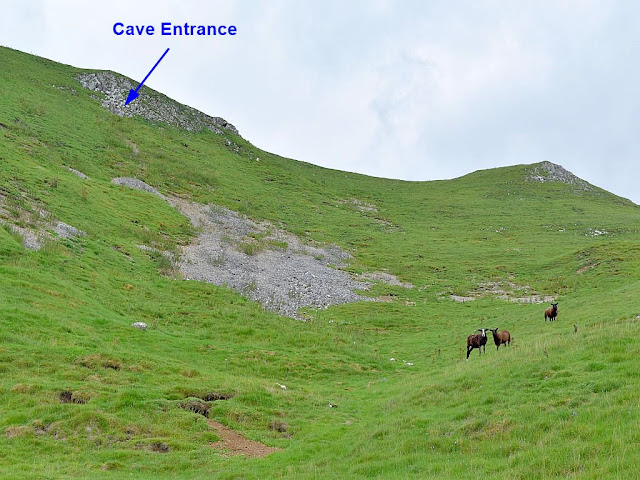
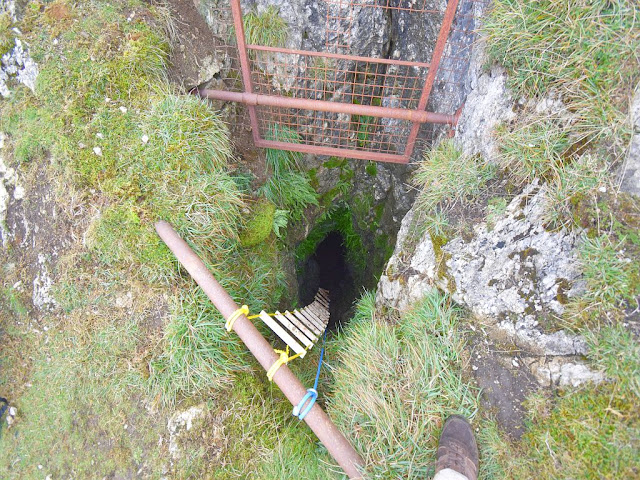

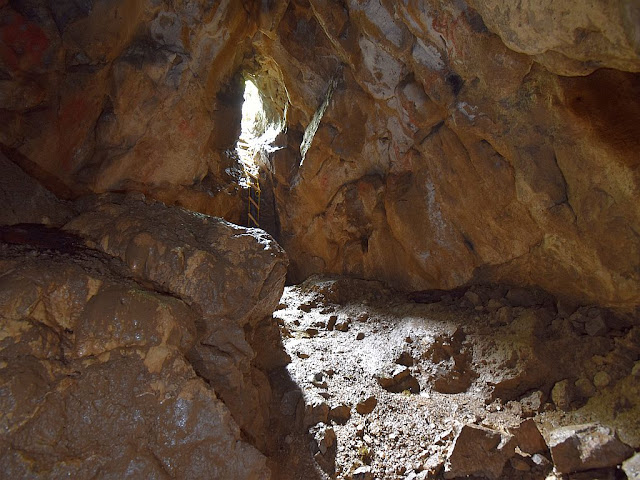
Post a Comment